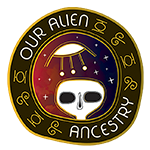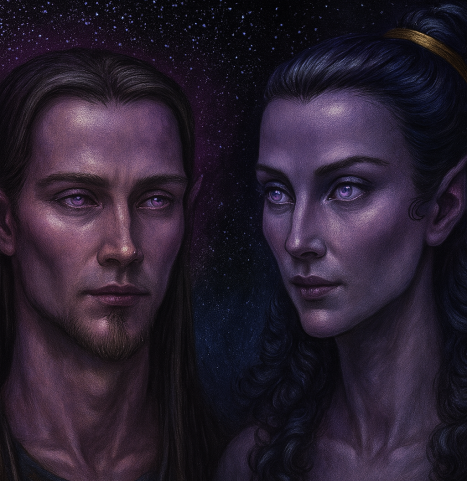
Humans once believed they were the only species in this universe, but this couldn’t be further from the truth. Some say that microbes found on different worlds are signs of extra-terrestrial life. Others debate that sapient life must be lingering out there, considering the trillions of worlds that could nurture life to reach our level—or beyond.
Many people throughout the ages have spoken about higher beings—either as gods, spirits, or aliens—visiting us for a variety of reasons: some to impart wisdom, some to exchange knowledge, and some to share body.
Ancient peoples spoke of children being born of these unions. They were called divine ones, demi-gods, or even malformed demons. In modern times, people refer to them as hybrids—a mix of human and E.T. They often struggle with the realization that they’re neither one nor the other, never truly able to fit in with other humans, and they feel a natural attraction to the stars.
They know things they shouldn’t. They feel more deeply than their peers. Some have contact with their interstellar family and carry an unshakable itch—a sense that they are something more.
I know this, because I am one of them.
There are many different types of hybrids. They can share DNA with various E.T. species, often in small percentages. For most, it sits below 5%. The most common type of hybrid in that category would be known as Starseeds, Homo novis, or Star People—the latter being the most accurate label. If the percentage were any higher, there would be drastic physical and mental differences that many on Earth would find alarming.
But what’s the point?
Some contactees say that certain E.T. species struggle to reproduce and require a genetic reset. This is why some people report that their reproductive cells were taken—or that children were conceived and then taken away. Other species mix and uplift hybrids (Star People) to create liaisons—living bridges between humans and the greater interstellar community.
I am of this sort. I have been contacted since my earliest memories and have been told that their goal is to connect these groups—to soften the blow of E.T. presence on Earth for humans.
For the longest time, it was an incredibly lonely existence—until I heard from and met many others who shared the same past, and possibly, the same future.
It’s difficult to predict what Earth would be like post-contact. A few of my E.T. contacts have lived long enough to witness other worlds go through First Contact. Some of those worlds couldn’t handle the enormity of such a realization and ended up annihilating themselves. Others embraced the change.
Either way, when humanity reaches that precipice, it will never be the same again. One thing my contacts have assured me—and many other contactees—is this: one can never have too many Star People on a world to help ease the transition.
Star People, like other hybrids, tend to exhibit physical and mental traits of their E.T. predecessors.
If their E.T. kin are nocturnal, the hybrid may prefer night.
If their kin are sensitive to emotions, the hybrid may be empathic.
If their kin are aquatic, the hybrid may feel drawn to water every chance they get.
It heavily depends on the species and their traits.
Another factor is how often the Star Person has been contacted, and how much they’ve learned about their interstellar kin. Through that learning, they may adopt certain behaviors and mannerisms—this was true in my case.
For instance, most of my contacts have been with one species: the Ezoni. They are the ones I’m most drawn to. Over the years, I discovered that we share a small physical relation.
I’ve observed how they speak to others, how easily they navigate social situations, how their eyes seem to gaze miles deep into someone when they link, and the electric smile that spreads across their face in a moment of pure contentment with the universe.
Not saying I can do all of that—but I’ve always been enchanted by it and have tried to emulate their behavior, especially in high school.
When I was old enough to understand, one of my closest contacts—Antajisan (nicknamed An)—revealed how Star People are made. More specifically, how I was made.
Several unfertilized eggs were taken and spliced from my mother. The parts that were removed were replaced with genetic material from a portion of An’s eggs. Once this was completed, the embryo was returned—and about a year later, I was born.
There are other methods:
- Adding material to already fertilized eggs.
- Modifying an already growing fetus.
- Inheriting hybrid genetics from one or both parents.
The latter is also common—many people speak of their parents or grandparents having E.T. experiences. An told me that the method used in my case was the simplest and most efficient.
I had always considered An a teacher, but I had sensed a deeper connection. She is, in fact, my other parent.
This isn’t unique to me—I later found out that some Star People are not only spiritually related to certain E.T.s, but biologically as well.
Recently, I asked An if she had other “children.” She said:
“Everyone in my line (line of work) has a handful of you (Star People). Our responsibilities stretch across many. We watch you grow and learn what you can do.”
“Do what?” I asked.
“Anything. We see where your talents are, and we expand on them. No one child can do it all. That is why there are so many—to make any change.”
“Is that our purpose?”
“We don’t tell you what your purpose is; we just show you what it can be,” she said.
Despite the thousands (possibly hundreds of thousands) of Star People on Earth, not all are aware of their heritage or individual purpose. I cannot say for sure why this is. Perhaps they haven’t had enough contact—or don’t consciously remember it. But with enough digging, the answer will surface.
Sometimes the burden is so overwhelming that it’s understandable why some want to be free of it. I’ve met a few who have completely rejected further contact with E.T.s, wishing to have all memories and abilities removed.
It’s a difficult existence.
Life on Earth is already filled with horror—but imagine also carrying the weight of knowing you’re torn between two worlds.
And knowing there are better ones out there.
Countless times I’ve astral traveled to these other places with my contacts and witnessed life in true harmony—with itself, with its world, and with the universe around it. In those moments, I asked:
Is it possible for us to reach this?
Will I—and other Star People—ever see this on Earth?
But life is a bundle of choices. And every choice—though some may seem easier—is not without challenge.
There were times I needed my contacts for help, but they refused, believing I could overcome it on my own. It’s that struggle that made me—and other Star People—so resilient and strong.
We’re constantly pushing forward toward something better.
Something we can teach to others here on Earth.
E.T.s are not in the habit of cleaning up another species’ mess—especially if they know that species can handle it with the right guidance.
That’s where hybrids come in.
It’s our responsibility—using our knowledge and abilities—to do something meaningful that improves the welfare of all life on this world.
We need to show the E.T.s who have dedicated their time, commitment, and love that we do have what it takes—not only to reach First Contact and join the interstellar community as equals, but to help Earth become what it can and should be.
I cannot say this will happen in one generation—or even the next—but if we start now, we can leave this world knowing it was a better place than the one we were born into.



